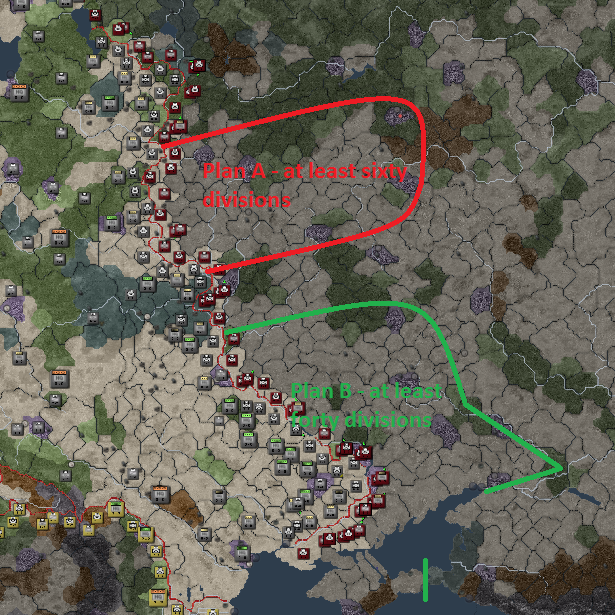Not bad! With your initial failures to eliminate the Soviets, I figured that you were going to inevitably lose but fight valiantly along the way (a rare treat, in my opinion  ). However, I am now confident that things are beginning to look up for you
). However, I am now confident that things are beginning to look up for you  The only thing better than a valiant loss is turning the situation on its head!
The only thing better than a valiant loss is turning the situation on its head!
The German Reich and the Second World War
- Thread starter enigmamcmxc
- Start date
-
We have updated our Community Code of Conduct. Please read through the new rules for the forum that are an integral part of Paradox Interactive’s User Agreement.
You are using an out of date browser. It may not display this or other websites correctly.
You should upgrade or use an alternative browser.
You should upgrade or use an alternative browser.
I've completed a similarly difficult operation. In order to free your divisions from line duty, i would assign the Ukrainian border provinces to Romanian and Hungarian forces, (if they are allied, quickly puppet them if not. Its worth it as they are passable flank protection). In the end, i had axis puppets manning the front all the way to Moscow as i had huge manpower black hole to contend with. I could not have defeated the Sovs without them. Micro-Managing their target provinces is a pain however.
Thanks for all the comments guys!
I had to take a little break to reorganize, but resumed offensive has made excellent progress. I will update soon.
I am a little reluctant to puppet and bring my allies into the war, although since I will be racking the difficulty all the war up at the start of '44, I guess I might if things get too dire. I noticed recently that the Italians are now at war with the Soviet Union, I have no idea when that happened, but they have confined themselves to just a naval campaign. Likewise, the French declared war on the Soviets when the world war kicked off. I loaded up as the French to check out their numbers, for one of the updates, and noted they were redeploying a hell load of their troops eastwards. They have yet to arrive so I have no idea what the AI is up to. On a positive note, since the beginning of my war with the Soviets I have had constant Belgian and Dutch air support.
I had to take a little break to reorganize, but resumed offensive has made excellent progress. I will update soon.
I am a little reluctant to puppet and bring my allies into the war, although since I will be racking the difficulty all the war up at the start of '44, I guess I might if things get too dire. I noticed recently that the Italians are now at war with the Soviet Union, I have no idea when that happened, but they have confined themselves to just a naval campaign. Likewise, the French declared war on the Soviets when the world war kicked off. I loaded up as the French to check out their numbers, for one of the updates, and noted they were redeploying a hell load of their troops eastwards. They have yet to arrive so I have no idea what the AI is up to. On a positive note, since the beginning of my war with the Soviets I have had constant Belgian and Dutch air support.
In my game. To get my allied/puppets armies to do anything other than mill about aimlessly, I made border provinces (on my side of the line) their targets. Works okay apart from that they eat more local supplies.
Last edited:
Completion
The final days of September saw the U-Boat campaign come to an end. It had achieved its tactical goal of the year: sinking 100 cargo vessels of the British Empire. In total, since the start of the world war, 1,736,000 tonnes of Allied shipping had been sunk. All boats were ordered to return to port, and the 'Afrika Legion' was ordered to depart for mainland Europe. With the condors and U-Boats in port, a huge saving in fuel would be achieved. Initial predictions had suggested that the war economy would have ground to a halt by now due to excessive fuel consumption. While the stats proved extremely worrying, reality was different. Very little fuel was actually being consumed. It was not all good news. On the 29th, the United Kingdom announced to the world its conquest of Thailand and its invasion of Indochina.
The final day of the month also saw the launch of the next phase of Operation Teutonic. While the final battles were taking place in the Pripet marshes, Army Group North Ukraine was downsized and took up defensive positions along the Dnieper. Army Group South Ukraine was vastly reinforced. Twelfth Army was positioned around the western flank of the frontline, and Ninth Army was deployed along the line facing south. Aerial reconnaissance over the preceding days indicated that the Red Army was building up its forces in this area, expecting the climactic battle of 1943.
On the morning of the 30th, as the entire medium bomber force and 12 wings of light bombers struck Red Army frontline positions, three divisions of the Ninth Army lunged forward opening the battle. 900 fighters took to the skies above the southern battle zone. During the day, they accounted for at least 120 Soviet fighters for the loss of 100 of our own. The Red Army fighters retreated from the battle, and over the coming days the Luftwaffe savaged the Red Air Force bomber wings taking control of the skies.
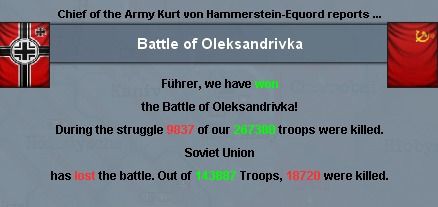
The Battle of Oleksandrivka was a grueling one. As soon as the Ninth Army divisions secured the initial Soviet defensive lines, divisions from the Eleventh Army – the main striking force for the operation – pushed forward to take the next series of defensive points. For 18 days, the men of the Eleventh Army (supported by a handful of units from the Ninth) pushed forward slowly driving the Red Army back until the crust of the frontline was cracked. With the frontline breached, three panzer armies were unleashed south.

On 19 October, as the infantry and armored divisions moved south, international news broadcasts announced that Indochina had fallen to British forces. Our own advance cut off a large Soviet force on the banks of the Dnieper, unable to retreat across the river. As more troops pushed forward, a sizeable force had to be held back to deal with this pocket as per their doctrine the Red Army went into overdrive to save their comrades. A week long battle, taking till the end of the month, was fought to destroy this pocket resulting in over 50,000 Red Army soldiers being taken captive.

The Soviet line of retreat marked in orange.
By the time the pocket had collapsed, some divisions had already reached the southern banks of the Dnieper and were attempting to cross. The Red Army (to the west of our penetration) was in retreat, fleeing through the only available corridor to safety. This influx of troops onto the south side of the river blocked all attempts to seize crossings via coup de main. The forces holding out to the east of our penetration, and on the west side of the river, had blunted our attacks and launched their own counterattacks aimed at saving troops trapped in the middle of our area of operations.
The Red Army was now seriously holding up the attack, thus the Fifteenth Army and the remaining panzer armies were committed to the battle. The nest of Soviet resistance, in the middle of all the fighting, collapsed netting a further 30,000 prisoners and the newly arrived troops started rolling up the Soviet positions west of the penetration bagging over 50,000 more. Regardless of the success, the Soviets were still putting up a fight thus the Fourteenth Army was also ordered into the fight.
On 23 November, Odessa Nova and its nuclear facility fell to our troops. The Soviet line in this sector buckled, and by the 29th all Red Army troopers had been thrown across the Dnieper. The fighting in this sector had been so severe and the Waffen-SS divisions fighting so recklessly, that one of the divisional commanders was killed in the fighting: a first for the war.
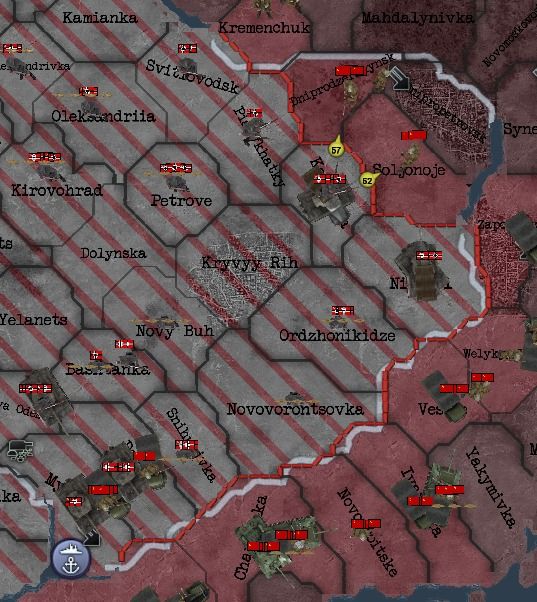
The frontline at the end of November.
Near Kherson, an attempt was made to cross the river. Around Dnipropetrovsk, the Red Army launched a counteroffensive taking back some territory. Back and forth fighting developed that dragged on into December. The weather, so far, had held. The temperatures, while cold, were not below freezing and there had been little rain or snow. As December wore on, rain broke out across the battlefield. The terrain turned to mud, and no further progress could be made. The fighting was called off on the 15th. Dnipropetrovsk, and a small stretch of territory the north, was all that remained of the Red Army positions west of the Dnieper. On the whole, Operation Teutonic had achieved its primary goal.
The final days of September saw the U-Boat campaign come to an end. It had achieved its tactical goal of the year: sinking 100 cargo vessels of the British Empire. In total, since the start of the world war, 1,736,000 tonnes of Allied shipping had been sunk. All boats were ordered to return to port, and the 'Afrika Legion' was ordered to depart for mainland Europe. With the condors and U-Boats in port, a huge saving in fuel would be achieved. Initial predictions had suggested that the war economy would have ground to a halt by now due to excessive fuel consumption. While the stats proved extremely worrying, reality was different. Very little fuel was actually being consumed. It was not all good news. On the 29th, the United Kingdom announced to the world its conquest of Thailand and its invasion of Indochina.
The final day of the month also saw the launch of the next phase of Operation Teutonic. While the final battles were taking place in the Pripet marshes, Army Group North Ukraine was downsized and took up defensive positions along the Dnieper. Army Group South Ukraine was vastly reinforced. Twelfth Army was positioned around the western flank of the frontline, and Ninth Army was deployed along the line facing south. Aerial reconnaissance over the preceding days indicated that the Red Army was building up its forces in this area, expecting the climactic battle of 1943.
On the morning of the 30th, as the entire medium bomber force and 12 wings of light bombers struck Red Army frontline positions, three divisions of the Ninth Army lunged forward opening the battle. 900 fighters took to the skies above the southern battle zone. During the day, they accounted for at least 120 Soviet fighters for the loss of 100 of our own. The Red Army fighters retreated from the battle, and over the coming days the Luftwaffe savaged the Red Air Force bomber wings taking control of the skies.

The Battle of Oleksandrivka was a grueling one. As soon as the Ninth Army divisions secured the initial Soviet defensive lines, divisions from the Eleventh Army – the main striking force for the operation – pushed forward to take the next series of defensive points. For 18 days, the men of the Eleventh Army (supported by a handful of units from the Ninth) pushed forward slowly driving the Red Army back until the crust of the frontline was cracked. With the frontline breached, three panzer armies were unleashed south.

On 19 October, as the infantry and armored divisions moved south, international news broadcasts announced that Indochina had fallen to British forces. Our own advance cut off a large Soviet force on the banks of the Dnieper, unable to retreat across the river. As more troops pushed forward, a sizeable force had to be held back to deal with this pocket as per their doctrine the Red Army went into overdrive to save their comrades. A week long battle, taking till the end of the month, was fought to destroy this pocket resulting in over 50,000 Red Army soldiers being taken captive.

The Soviet line of retreat marked in orange.
By the time the pocket had collapsed, some divisions had already reached the southern banks of the Dnieper and were attempting to cross. The Red Army (to the west of our penetration) was in retreat, fleeing through the only available corridor to safety. This influx of troops onto the south side of the river blocked all attempts to seize crossings via coup de main. The forces holding out to the east of our penetration, and on the west side of the river, had blunted our attacks and launched their own counterattacks aimed at saving troops trapped in the middle of our area of operations.
The Red Army was now seriously holding up the attack, thus the Fifteenth Army and the remaining panzer armies were committed to the battle. The nest of Soviet resistance, in the middle of all the fighting, collapsed netting a further 30,000 prisoners and the newly arrived troops started rolling up the Soviet positions west of the penetration bagging over 50,000 more. Regardless of the success, the Soviets were still putting up a fight thus the Fourteenth Army was also ordered into the fight.
On 23 November, Odessa Nova and its nuclear facility fell to our troops. The Soviet line in this sector buckled, and by the 29th all Red Army troopers had been thrown across the Dnieper. The fighting in this sector had been so severe and the Waffen-SS divisions fighting so recklessly, that one of the divisional commanders was killed in the fighting: a first for the war.

The frontline at the end of November.
Near Kherson, an attempt was made to cross the river. Around Dnipropetrovsk, the Red Army launched a counteroffensive taking back some territory. Back and forth fighting developed that dragged on into December. The weather, so far, had held. The temperatures, while cold, were not below freezing and there had been little rain or snow. As December wore on, rain broke out across the battlefield. The terrain turned to mud, and no further progress could be made. The fighting was called off on the 15th. Dnipropetrovsk, and a small stretch of territory the north, was all that remained of the Red Army positions west of the Dnieper. On the whole, Operation Teutonic had achieved its primary goal.
Last edited:
Summing up
Operation Teutonic aimed to push the Soviet military beyond the Dnieper River. With the small exception of Dnipropetrovs, the operation had been a complete success. Had the fighting at the beginning of the year and the redeployment of forces taken less time, the success of the operation could have potentially been even greater.
As it was, the Red Army had massed it forces to face the buildup facing them. Their resistance had cost them dearly. When the operation was launched, it was believed the Red Army had 400 divisions. Now, the intelligence community estimated the Red Army had 346 divisions left on its order of battle. This suggested a loss of only 54 divisions, a far cry from reality.
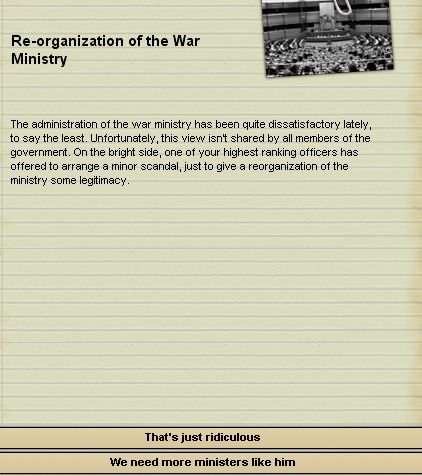
While Operation Teutonic raged on,
on the Home Front the army started the process of inflicting its will upon the politicians.
Operation Teutonic had inflicted a grand total of 432,815 casualties on the Red Army, and resulted in the capture of a further 444,312 men. As a result of this single operation, the Soviet military had lost a little under 900,000 men. Assuming the Soviet divisions were at full strength when they were captured (which is a big assumption), at least 44 whole formations were captured and written off the Red Army order of battle. That would leave a ten division shortfall, based off the intelligence community estimates, and that figure was far exceeded by the number of deaths inflicted of the Soviet military.
Operation Teutonic was not the only fighting that took place during 1943. The fighting in the north had, on its own, inflicted heavy losses on the Red Army. Thus, during 1943, the Soviet casualty figure amounted to 581,256 killed and 785,937 captured. 1.3 million Red Army troopers had been accounted for. Since the start of the war with the Soviet Union, 3.1 million Red Army soldiers had been rendered casualties. On the other hand, our own losses were modest. Operation Teutonic had resulted in the deaths of 260,041 men. In total, the army and the Waffen-SS lost 375,723 men during 1943. The war on the Eastern Front had thus far accounted for only one million men.
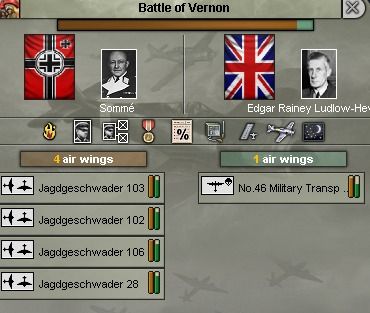
An odd event, which took place during the November. Massed British transport planes were intercepted heading for Paris.
50 planes were shot down, but the wrecks were that badly mangled that it was impossible to determine the purpose of the flight.
The air battle in support of Operation Teutonic resulted in at least 750 confirmed single-engine Red Air Force fighters destroyed, along with 80 twin-engine fighters. At least 250 medium bombers had been shot down, along with 50 of the heavily armored IL-2 bombers. In seizing control of the airspace above the battlefield, the Luftwaffe suffered the loss of 430 fighters. 160 light and 130 medium bombers were lost in support of the fighting on the ground.
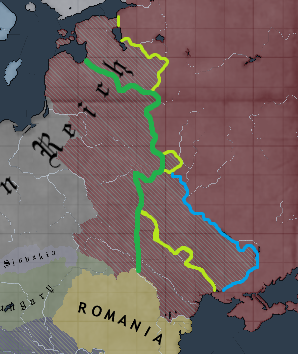
Green = Case Barbarossa gains
Lime Green = Case Wilhelm gains
Blue = Case Teutonic gains
The 'Afrika Legion' was pulled out of North Africa just in time. Between their departure and the end of fighting on the Eastern Front, Anglo-American troops had overrun French North Africa. Unless the Allies decide on a Japan-first policy, it would seem that during 1944 they will attempt some form of invasion of Europe. Enough troops are based in Gaul to deter any landings and protect the ports, likewise the Dutch and Belgian troops are protecting their own ports and reinforcing our troops based in their ports. Two likely possibilities therefore exist. First, considering the weak strength of the French State an Allied landing could happen in Southern France. Second, while the Italians have a strong military, they have still been unable to defeat the Greeks and this leaves room for troops to deploy behind the Greeks and then attack. Therefore, the strategic situation demands more troops be deployed to France to reinforce the French State and that a strong reserve is built up inside Germany to be deployed south or west depending on the situation.
On the Eastern Front, as soon as the ground solidifies during the winter, and attempt will be made to take Dnipropetrovs. While no plans had yet been drawn up for 1944, two options appeared to be the main choices: A) a continued advance in the Ukraine aiming for the Don River while overrunning the remaining industrial centers or B) redeploy the majority of troops into Army Group Center's operational area, and launch an offensive aimed at capturing Moscow.
Operation Teutonic aimed to push the Soviet military beyond the Dnieper River. With the small exception of Dnipropetrovs, the operation had been a complete success. Had the fighting at the beginning of the year and the redeployment of forces taken less time, the success of the operation could have potentially been even greater.
As it was, the Red Army had massed it forces to face the buildup facing them. Their resistance had cost them dearly. When the operation was launched, it was believed the Red Army had 400 divisions. Now, the intelligence community estimated the Red Army had 346 divisions left on its order of battle. This suggested a loss of only 54 divisions, a far cry from reality.

While Operation Teutonic raged on,
on the Home Front the army started the process of inflicting its will upon the politicians.
Operation Teutonic had inflicted a grand total of 432,815 casualties on the Red Army, and resulted in the capture of a further 444,312 men. As a result of this single operation, the Soviet military had lost a little under 900,000 men. Assuming the Soviet divisions were at full strength when they were captured (which is a big assumption), at least 44 whole formations were captured and written off the Red Army order of battle. That would leave a ten division shortfall, based off the intelligence community estimates, and that figure was far exceeded by the number of deaths inflicted of the Soviet military.
Operation Teutonic was not the only fighting that took place during 1943. The fighting in the north had, on its own, inflicted heavy losses on the Red Army. Thus, during 1943, the Soviet casualty figure amounted to 581,256 killed and 785,937 captured. 1.3 million Red Army troopers had been accounted for. Since the start of the war with the Soviet Union, 3.1 million Red Army soldiers had been rendered casualties. On the other hand, our own losses were modest. Operation Teutonic had resulted in the deaths of 260,041 men. In total, the army and the Waffen-SS lost 375,723 men during 1943. The war on the Eastern Front had thus far accounted for only one million men.

An odd event, which took place during the November. Massed British transport planes were intercepted heading for Paris.
50 planes were shot down, but the wrecks were that badly mangled that it was impossible to determine the purpose of the flight.
The air battle in support of Operation Teutonic resulted in at least 750 confirmed single-engine Red Air Force fighters destroyed, along with 80 twin-engine fighters. At least 250 medium bombers had been shot down, along with 50 of the heavily armored IL-2 bombers. In seizing control of the airspace above the battlefield, the Luftwaffe suffered the loss of 430 fighters. 160 light and 130 medium bombers were lost in support of the fighting on the ground.

Green = Case Barbarossa gains
Lime Green = Case Wilhelm gains
Blue = Case Teutonic gains
The 'Afrika Legion' was pulled out of North Africa just in time. Between their departure and the end of fighting on the Eastern Front, Anglo-American troops had overrun French North Africa. Unless the Allies decide on a Japan-first policy, it would seem that during 1944 they will attempt some form of invasion of Europe. Enough troops are based in Gaul to deter any landings and protect the ports, likewise the Dutch and Belgian troops are protecting their own ports and reinforcing our troops based in their ports. Two likely possibilities therefore exist. First, considering the weak strength of the French State an Allied landing could happen in Southern France. Second, while the Italians have a strong military, they have still been unable to defeat the Greeks and this leaves room for troops to deploy behind the Greeks and then attack. Therefore, the strategic situation demands more troops be deployed to France to reinforce the French State and that a strong reserve is built up inside Germany to be deployed south or west depending on the situation.
On the Eastern Front, as soon as the ground solidifies during the winter, and attempt will be made to take Dnipropetrovs. While no plans had yet been drawn up for 1944, two options appeared to be the main choices: A) a continued advance in the Ukraine aiming for the Don River while overrunning the remaining industrial centers or B) redeploy the majority of troops into Army Group Center's operational area, and launch an offensive aimed at capturing Moscow.
Wow, the Eastern Front is slowly being eaten up by the German Army. What are your plans after Russia completely falls?
All is going as according to plan. Except Italy of course. That's gonna beva problem.
Thanks for all the comments guys!
I too, have a bad feeling about Italy. It seems all their forces are in Greece, so if the Allies land in Italy ... hell there might be a rapid advance north and screw everything up for me!
The last week has been hectic with uni, and the upcoming weeks are going to be just as bad ... so I don't think there will be time for any updates soon.
I too, have a bad feeling about Italy. It seems all their forces are in Greece, so if the Allies land in Italy ... hell there might be a rapid advance north and screw everything up for me!
The last week has been hectic with uni, and the upcoming weeks are going to be just as bad ... so I don't think there will be time for any updates soon.
Sorry for the delay. I am now back in action, although with more uni deadlines coming there may be another prolonged break soon.
Christmas Planning Session
With the completion of Case Teutonic and the Red Army being in no state to launch a major counterattack, all senior officers on the Eastern Front have been called to Warsaw – the location of OKH’s headquarters – for a series of meetings on how to conduct the 1944 campaign.
As of the end of the year, the military on the Eastern Front broke down as follows:
Therefore, the total number of available units that can be transferred for an offensive are:
Over the course of the year our meager spy network in the Soviet Union has been eliminated. Regardless of the lack of spies, the Abwehr – using all other means possible – believe that the Soviet Union has at least 340 divisions. Using information gathered from frontline reconnaissance coupled with other estimated, the Soviet forces are believed to be dispersed as follows:
Due to the terrain of northern Russia, coupled with the lack of targets other than Leningrad, the assembled staff rejected a northern offensive. Instead, they began planning two offensives. Plan A an offensive by Army Group Centre, and Plan B: continuing the fight in the Ukraine.
Army Group Centre would be reinforced and, using the open terrain between the northern and southern forests, launch a major offensive aimed at capturing the Soviet capital. The attack would be launched in three phases:
To undertake the operation, the army groups in the south would have to be stripped to the bare minimum and the reserves moved up. All five panzer armies would be required. The operation would overrun between five and six major industrial centers and capture the capital, which could bring about the end of the war on the Eastern Front. However, if the war did not end the territory gained from such an operation would require at least sixty divisions committed to hold the new frontline leaving only a handful and perhaps the panzer divisions to be released for future operations.
Plan B envisions a continuation of the fighting in the Ukraine. Considering the losses inflicted on the Red Army in the previous campaigns and recognizing the limitations of our forces, the plan has no ultimate goal and rather suggests attempting to seize control of the next river line: the Donets. This would also largely liberate the Ukraine from Soviet control. As per Plan A, Plan B would be launched in a number of phases:
It is estimated that the plan would require at least 60 infantry divisions and the entire panzer force to launch. Afterwards, only 40 divisions would be required to hold the territory gained and the panzer force could also be released. The offensive, if completely successful, would overrun at least seven major industrial centers.
While Plan A could result in a war winning offensive, if it failed to achieve its overall objective of Moscow or if the Soviets refused to surrender then the offensive capability of our armed forces will have been lost. The initiative will pass to the Soviets. Since Plan B would allow for the release of forces on its completion, thereby retaining the initiative, it is the logical choice as it does not remove our ability to attack. Furthermore, Plan B allows for the capture of more industrial sites and the possibility of inflicting greater losses on the Red Army than an assault in the center would.
Background
With the completion of Case Teutonic and the Red Army being in no state to launch a major counterattack, all senior officers on the Eastern Front have been called to Warsaw – the location of OKH’s headquarters – for a series of meetings on how to conduct the 1944 campaign.
Our Forces
As of the end of the year, the military on the Eastern Front broke down as follows:
- Army Group North has and needs 26 divisions (including security forces) to hold the northern sector.
- Army Group Centre currently has and needs 26 combat ready divisions (security divisions excluded) to hold the central front. This includes two very strong Corps holding the eastern tip of the Pripet marshes, the weakening of this position being deemed hazardous to the entire frontline.
- The two army groups in the Ukraine have 79 combat divisions and the five panzer armies (30 panzer divisions and 11 mobile infantry formations) but would only need around 40 to hold the frontline.
- In addition, there is a reserve of three infantry divisions, three airborne divisions, and two mountain divisions.
Therefore, the total number of available units that can be transferred for an offensive are:
- 42 infantry divisions
- 30 panzer divisions
- 11 mobile divisions
- 3 airborne divisions
- 2 mountain divisions
Soviet Forces
Over the course of the year our meager spy network in the Soviet Union has been eliminated. Regardless of the lack of spies, the Abwehr – using all other means possible – believe that the Soviet Union has at least 340 divisions. Using information gathered from frontline reconnaissance coupled with other estimated, the Soviet forces are believed to be dispersed as follows:
- 50 divisions facing Army Group North
- 50 divisions facing Army Group Centre, all within the area of Plan A
- 110 divisions facing our forces in the Ukraine, with at least 80 divisions concentrated within the area of Plan B.
- An estimated 20 divisions in reserve behind the length of the frontline, positioned in major cities or at airbases and ports.
Outline
Due to the terrain of northern Russia, coupled with the lack of targets other than Leningrad, the assembled staff rejected a northern offensive. Instead, they began planning two offensives. Plan A an offensive by Army Group Centre, and Plan B: continuing the fight in the Ukraine.
Plan A
Army Group Centre would be reinforced and, using the open terrain between the northern and southern forests, launch a major offensive aimed at capturing the Soviet capital. The attack would be launched in three phases:
- Phase 1: At the northern and southern tips of the Army Group Center’s sector, two break-in battles would be launched.
- Phase 2: Following the successful break-in battles, two panzer armies would be unleashed through each gap. They would advance east before moving to link up with each other and create a vast pocket. Then, in cooperation with the various infantry armies, the pocket would be crushed aiming to destroy between 25 and 30 divisions (an estimated 200,000 men).
- Phase 3: The panzer armies, reinforced with the remaining panzer army, would drive on Moscow and capture the capital. In the meantime, the infantry armies would secure the flanks and other phase lines.
To undertake the operation, the army groups in the south would have to be stripped to the bare minimum and the reserves moved up. All five panzer armies would be required. The operation would overrun between five and six major industrial centers and capture the capital, which could bring about the end of the war on the Eastern Front. However, if the war did not end the territory gained from such an operation would require at least sixty divisions committed to hold the new frontline leaving only a handful and perhaps the panzer divisions to be released for future operations.
Plan B
Plan B envisions a continuation of the fighting in the Ukraine. Considering the losses inflicted on the Red Army in the previous campaigns and recognizing the limitations of our forces, the plan has no ultimate goal and rather suggests attempting to seize control of the next river line: the Donets. This would also largely liberate the Ukraine from Soviet control. As per Plan A, Plan B would be launched in a number of phases:
- Phase 1: Once the weather has improved, attacks would be launched to destroy the Soviet bridgehead on the east side of the Dnieper River.
- Phase 2: A bridgehead across the southern stretch of Dnieper River would seized, followed by a strike south to reach the coast of the Sea of Azov.
- Phase 3: Soviet forces would then be cleared from along the coast.
- Phase 4: The Crimea will then be cleared of Soviet forces. It is expected by this point, that around 30 divisions will have been destroyed.
- Phase 5: Bridgeheads, across the Dnieper, in the general vicinity of Kiev are to then be seized.
- Phase 6: With a secure bridgehead, a general offensive eastward is then to be launched. The attack would attempt to destroy as many formations as possible and aim to at least reach the Donets River.
It is estimated that the plan would require at least 60 infantry divisions and the entire panzer force to launch. Afterwards, only 40 divisions would be required to hold the territory gained and the panzer force could also be released. The offensive, if completely successful, would overrun at least seven major industrial centers.
Conclusions
While Plan A could result in a war winning offensive, if it failed to achieve its overall objective of Moscow or if the Soviets refused to surrender then the offensive capability of our armed forces will have been lost. The initiative will pass to the Soviets. Since Plan B would allow for the release of forces on its completion, thereby retaining the initiative, it is the logical choice as it does not remove our ability to attack. Furthermore, Plan B allows for the capture of more industrial sites and the possibility of inflicting greater losses on the Red Army than an assault in the center would.
I'm not sure that capturing Moscow will be enough. In fact, I wouldn't be surprised if that did turn out to be insufficient. Obviously, the loss of all stockpiles would greatly hamper the SU, but IMO it wouldn't cause it to surrender immediately. In the South, perhaps it would be wise to focus on limited objectives, like destroying the Soviet forces in Crimea?
How about first plan B, followed by a modified plan A, where part of the offensive forces remaining after plan B link up with an offensive from north of the marshes?
Plan B sounds like it's the best course of action. Where would you begin your attack from, and are you going to go for a mass encirclement or many smaller ones?


